Disclosure: We may earn commissions if you purchase products after clicking on a link from our site.
Deer drives for deer hunting is a hunting method used by many hunters. It is very effective and allows hunters to work as teams while deer hunting.
Deer drives require organization, communication, safety protocols, and readiness for quick changes. In this article, we discuss deer drives for deer hunting to help you be more successful when implementing this hunting method.
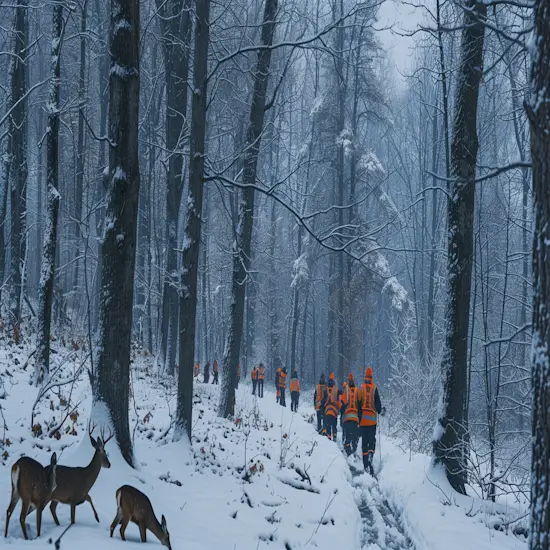
Table of Contents
- 1 Key Takeaways
- 2 Safety Measures
- 3 Stander Setup
- 4 Deer Movement Strategies
- 5 Communication and Coordination
- 6 Adaptability and Preparedness
- 7 Post-Drive Analysis
- 8 Hunting Techniques
- 9 Additional Tips and Considerations
- 10 Public Land Considerations
- 11 Team Organization
- 12 The Bottom Line
Key Takeaways
- Prioritize safety measures for successful deer drives.
- Strategic stander positioning to increase drive success.
- Effective communication and coordination among participants.
- Conduct thorough post-drive analysis for improvements.
- Utilize scent techniques and adaptability for successful drives.
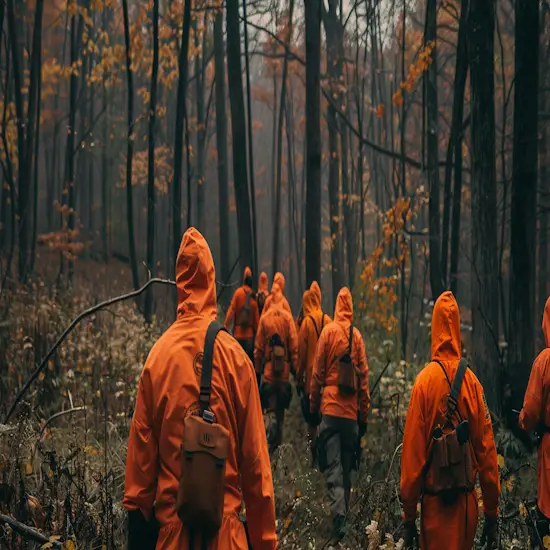
Safety Measures
When preparing for a deer drive, always keep safety at the forefront of your mind. Make sure everyone knows the safe shooting directions, position standers strategically, communicate effectively, and emphasize the importance of post-drive analysis. Make sure everyone wears hunter orange for safety. Prioritizing safety measures is essential for a successful and incident-free deer drive.
Shooting Direction Awareness
Are you aware of the essential safety measures regarding shooting directions during a deer drive? Ensuring safe shooting directions is critical to prevent safety issues.
Always be mindful of where your shots are aimed and avoid shooting towards areas where other hunters may be present. It’s important to communicate effectively with your hunting party about shooting zones and establish clear boundaries.
Before taking a shot, positively identify your target and what lies beyond it to prevent any mishaps. Remember, safety should always be the top priority during a deer drive.
Standers Strategic Positioning
Strategically positioning standers is vital for maximizing the success of a deer drive while upholding safety measures. Standers should block escape routes for the deer being moved and be strategically located to prevent mature bucks from evading the drive. Understanding the terrain and deer behavior is essential for effective placement.
A well-planned setup increases the chances of driving a big buck toward the standers. It’s important for standers to always have their weapon ready and match it to shot opportunities. By following these guidelines, you can help guarantee a safe and successful deer drive.
Communication for Coordination
For effective coordination during a deer drive, clear communication among participants is essential to guarantee safety measures are upheld. Establish signals or calls to indicate the start and progress of the drive. Ensure all participants comprehend their roles and responsibilities. Effective communication helps prevent accidents and confusion during the drive. Encourage open dialogue and feedback among participants for a successful drive.
Walkers can signal standers of deer movement, enhancing overall coordination. Radio communication also plays a key role in ensuring the success and safety of the drive. By maintaining open lines of communication and staying alert to signals, participants can work together seamlessly, reducing risks and maximizing the effectiveness of the deer run.
Post-Drive Analysis Importance
To fully comprehend the impact and effectiveness of your deer drive, conducting a thorough post-drive analysis is vital. After the drive, gather all participants for a debrief session.
Evaluate how well the drive moved deer towards standers. Discuss any safety incidents or near misses that may have occurred. Collect feedback from everyone involved to improve future strategies.
This analysis is essential for refining tactics and ensuring safer, more successful drives in the future. Remember, learning from each drive helps enhance overall hunting experiences and keeps everyone safe.
Make post-drive analysis a standard practice to continuously improve your deer hunting skills and outcomes.
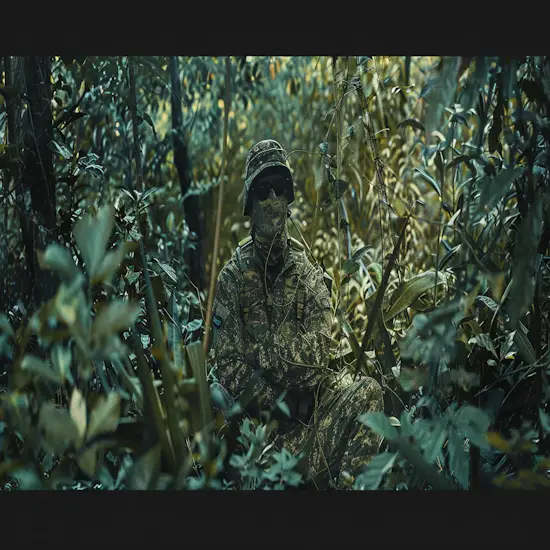
Stander Setup
Now let’s talk about strategic stander placement during deer drives. Position yourself carefully to block escape routes, ensuring you are armed and ready. Understanding the terrain and deer behavior is key to effectively placing standers.
Strategic Stander Placement
Strategic placement of standers is crucial for a successful deer drive. To maximize your chances, position standers to block escape routes for the deer. Understand the terrain and deer behavior to place standers effectively.
By strategically locating standers, you can prevent deer from evading the drive and increase the likelihood of driving them towards you. Always keep your weapon ready and match it to shot opportunities. A well-planned setup is key to a successful outcome.
Blocking Escape Routes
Position standers strategically to block escape routes for the deer during a deer drive. When setting up standers to block escape routes, consider the following:
- Terrain Understanding: Confirm standers are placed in areas where deer are likely to attempt an escape.
- Deer Behavior Analysis: Anticipate how deer might react and place standers accordingly.
- Strategic Location: Position standers at key points to prevent deer from circumventing the drive.
Ready Standers With Weapons
Make sure standers are armed with their weapons and prepared for action during a deer drive. Having their guns ready is essential for quick and effective responses when deer are directed toward them.
Match the type of gun to the shot opportunities that may arise during the drive. This preparation ensures that standers are equipped to take ethical shots when needed.
By having their weapons at the ready, standers increase the chances of a successful deer drive. Being proactive in arming standers appropriately contributes to the overall safety and efficiency of the hunting expedition.
Stay vigilant and keep weapons primed for action throughout the deer drive to capitalize on any shot opportunities that may present themselves.
Terrain Understanding for Placement
Understanding the terrain is essential for effectively placing standers during a deer drive.
- Study the Landscape: Familiarize yourself with the topography to identify potential stander placements.
- Consider Natural Funnels: Look for natural features like valleys or tree lines that can channel deer movement towards standers.
- Account for Wind Direction: Position standers downwind from expected deer approaches to prevent detection.

Deer Movement Strategies
When planning deer drives, consider utilizing natural obstacles like rivers, ridges, or thick cover to guide deer movement. Position standers strategically along these natural barriers to intercept deer effectively. Incorporating decoys and scents can also be a strategic way to lure deer in desired directions.
Natural Barriers Guidance
Utilize natural features like rivers, ridges, or dense vegetation to guide deer movement effectively during deer drives. Here are some tips to help you make the most of natural barriers:
- Rivers: Use rivers to funnel deer movement and create a natural barrier that can direct deer towards standers.
- Ridges: Position standers strategically along ridges to intercept deer as they move along these elevated natural features.
- Dense Vegetation: Take advantage of heavy cover to channel deer movement and increase the likelihood of driving deer towards standers.
Standers Along Obstacles
Position standers strategically along natural obstacles to effectively intercept and guide deer movement during deer drives. By placing standers near rivers, ridges, or dense vegetation, you can channel deer towards them, increasing success rates.
Understanding the terrain and deer behavior is key for ideal stander placement. Proper positioning along these barriers helps prevent deer from escaping the drive, ensuring a higher chance of encounters with standers. Utilizing natural features in your strategy enhances the effectiveness of the drive.
Decoys and Scents
When setting up for a deer drive, consider utilizing decoys strategically to attract deer toward standers. Using deer scents can also be effective in luring deer in desired directions during the drive. Proper placement of decoys and scents can enhance the overall effectiveness of your deer movement strategies.
Decoy Placement Strategies
To enhance the effectiveness of your deer drive, consider strategic placement of decoys to attract and guide deer movement towards standers.
- Position decoys within view of standers for best visibility.
- Place decoys in natural feeding or bedding areas to lure deer.
- Use decoys that mimic local deer species for authenticity.
Scent Utilization Techniques
Consider incorporating scents strategically to lure deer in desired directions during your deer drive. This can enhance the effectiveness of your hunting strategy. Using deer scents can attract deer and guide their movements. Placing scents carefully can lead deer toward standers, increasing your chances of a successful drive. Utilize this technique to improve your deer hunting results and make your deer drive more productive.
Attracting Deer Effectively
Enhance your deer hunting success by strategically using decoys and scents to attract deer effectively during your deer drives.
- Place decoys strategically to draw deer towards standers.
- Use deer scents to lure deer in desired directions.
- Enhance the effectiveness of your deer drive by incorporating decoys and scents in your hunting strategy.
Luring Deer Strategically
To strategically lure deer during a deer drive, consider utilizing scent attractants to draw them in. Place decoys tactically and use natural barriers to guide their movement. Also, strategically scent areas to direct deer where you want them to go.
These methods can enhance the effectiveness of your deer drive by manipulating deer movement patterns in a controlled manner. By incorporating these strategies, you can increase the chances of driving deer toward your standers successfully.
Scent Attractants for Deer
Utilize strategically placed scent attractants to entice deer effectively during deer drives.
- Use Deer Urine: Place deer urine near standers to attract deer.
- Employ Food Scents: Food scents can lure deer towards designated areas.
- Consider Mock Scrapes: Creating mock scrapes with scents can draw deer into specific locations.
Decoy Placement Tactics
Strategically positioning decoys can have a major impact on deer movement during a drive, increasing your chances of success.
Placing decoys near natural barriers or in open areas where deer can easily spot them can draw their attention and guide them towards standers.
Consider wind direction and line of sight to guarantee the decoys are visible and enticing. Proper decoy placement enhances the effectiveness of your deer drive strategy.
Using Natural Barriers
Position standers strategically along natural barriers to guide deer movement effectively during a drive.
- Use rivers, ridges, or dense vegetation to direct deer.
- Funnel deer towards standers for increased success.
- Intercept deer effectively by placing standers along natural barriers.
Strategic Deer Scenting
To enhance the effectiveness of your deer drive, consider strategically luring deer using scenting techniques. Using deer scents strategically can attract and guide deer in desired directions during the drive.
Place scents strategically to draw deer towards standers, increasing your chances of a successful hunt. Incorporating scenting techniques into your deer drive strategy can help maximize your hunting opportunities.

Communication and Coordination
Signal for the progress of the drive, clarify roles and encourage open dialogue among participants. Also, emphasize the importance of effective communication to prevent accidents and enhance coordination during the deer drive. Utilize radio communication to improve coordination and guarantee a successful hunting experience.
Signal for Drive Progress
During a deer drive, it’s crucial to establish clear signals to track the progress of the drive effectively. Here are some key points to take into account:
- Use predetermined signals to communicate the start and advancement of the drive.
- Make sure that all participants understand and recognize the signals being used.
- Implement a system that allows for immediate feedback and adjustments based on the progress signaled.
Having clear and understood signals will aid in the coordination of the deer drive, helping everyone involved to work together seamlessly towards a successful outcome.
Role Clarity Importance
Having clear roles and responsibilities is crucial for effective communication and coordination during a deer drive. When each participant understands their role, it helps in preventing accidents and ensuring the drive progresses smoothly.
Clearly defined responsibilities enable everyone to focus on their tasks, reducing confusion and enhancing safety. It’s essential to establish who’ll be walkers and standers, ensuring each person knows what’s expected of them. This clarity fosters teamwork and allows for better synchronization during the deer drive.
Open Dialogue Encouraged
To guarantee effective communication and coordination during a deer drive, fostering open dialogue among participants is key.
- Encourage all participants to share insights and feedback openly.
- Establish clear communication channels to keep everyone informed.
- Confirm that questions and concerns are addressed promptly.
Radio Enhances Coordination
Enhancing coordination during a deer drive is facilitated by utilizing radios to guarantee effective communication among participants. Radios enable instant updates on deer movement, ensuring everyone is informed and prepared.
By using radios, you can relay important information swiftly, such as the direction of the deer or any unexpected changes in the drive. This real-time communication enhances safety by preventing misunderstandings and accidents. It allows for quick adjustments to the strategy based on the evolving situation, increasing the drive’s overall success rate.
With radios in hand, participants can work together seamlessly, improving the coordination and efficiency of the deer drive. So, make sure your radio is tuned in and ready to enhance the coordination of your next deer hunting expedition.

Adaptability and Preparedness
When participating in deer drives, you need to be adaptable and prepared for any changes that may arise. Adjust your tactics based on weather conditions to enhance your chances of success. Stay ready for quick responses and guarantee your shots are always ethical for effective deer hunting.
Weather-Based Tactic Adjustments
How can you adapt your deer drive tactics based on changing weather conditions? Here are some tips to help you adjust your strategy effectively:
- Monitor the Weather: Keep an eye on weather forecasts before and during the deer drive to anticipate changes.
- Adjust Stand Positions: Modify the placement of standers based on wind direction and visibility affected by weather conditions.
- Prepare for Quick Changes: Be ready to alter the drive routes swiftly if weather conditions shift unexpectedly.
Adapting your deer drive tactics to the weather can greatly improve your chances of a successful hunt. Stay flexible and prepared for changing conditions to maximize your hunting experience.
Quick Response Readiness
Prepare yourself for quick responses during deer drives by staying alert and ready for action at all times. In the fast-paced environment of a deer drive, being adaptable and prepared is vital.
Stay focused on the task at hand, anticipate the movement of the deer and be ready to take action swiftly. Make quick decisions based on the changing dynamics of the drive, adjusting your tactics as needed. Being prepared for ethical shots and sudden opportunities is essential for success.
Keep your senses sharp, be aware of your surroundings, and maintain a readiness to respond promptly. By staying agile and responsive, you increase your chances of effectively contributing to the deer drive and achieving a successful outcome.
Ethical Shot Importance
To guarantee a successful deer drive, maintaining a focus on achieving ethical shots is of utmost importance.
- Always prioritize a clean and humane shot to minimize suffering.
- Make sure proper shot placement for a quick and effective takedown.
- Practice shooting skills regularly to be prepared for ethical shot opportunities.

Post-Drive Analysis
Now that the deer drive is over, it’s time to assess how it went. Take a moment to review how effective the drive was in moving deer toward the standers. Analyze any safety incidents or near misses that occurred during the drive to learn and improve for next time.
Drive Effectiveness Review
During the post-drive analysis, it is essential to review the effectiveness of moving deer towards standers and address any safety incidents or near misses that occurred.
Here are three key points to take into account during the drive effectiveness review:
- Evaluate the coordination and communication between walkers and standers.
- Analyze the impact of natural obstacles and decoys on guiding deer movement.
- Discuss any deviations from the planned strategy and their effects on the drive’s success.
Safety Incidents Analysis
In reviewing safety incidents post-deer drive, prioritize identifying the pivotal causes to prevent future accidents. Analyze factors like communication breakdowns, improper weapon handling, or stander positioning issues. Look for patterns to address underlying safety concerns effectively.
Discuss any near misses or accidents that occurred during the drive to learn from them. Collect feedback from participants to gain insights into potential safety improvements. Use this analysis to refine safety protocols and drive strategies for future hunts.
Participant Feedback Collection
Gather feedback from all participants promptly after the deer drive to evaluate the experience and identify areas for improvement.
- Ask participants about their observations during the drive.
- Inquire about any safety concerns or incidents that occurred.
- Seek suggestions for enhancing future deer drives.
Collecting feedback allows for a thorough post-drive analysis, helping refine tactics, improve safety measures, and guarantee more successful drives in the future. By actively engaging participants in the feedback process, you can gather valuable insights that contribute to the overall effectiveness and enjoyment of deer hunting through organized drives.

Hunting Techniques
Let’s talk about some important hunting techniques that can enhance your deer drives. Using scents and decoys effectively can lure deer towards standers, increasing your chances of success.
Scent Decoy Effectiveness
Enhance your deer hunting success by strategically using scent decoys to attract and guide deer during drives.
- Choose the Right Scent: Select scents that are appealing to deer in your area for better attraction.
- Proper Placement: Position scent decoys downwind from standers to lead deer in the desired direction.
- Regular Replenishment: Reapply scents periodically to maintain their effectiveness throughout the deer drive.
Using scent decoys effectively can greatly increase the chances of deer moving in the direction you desire during a deer drive. By following these simple tips, you can enhance the overall success of your hunting experience.
Safety in Noise
To guarantee safety in noise while hunting, contemplate the impact of loud sounds on your surroundings and the potential risks they may pose during deer drives. Excessive noise can startle deer, causing them to scatter unpredictably and potentially endangering nearby hunters.
When engaging in deer drives, be mindful of the noise levels you and your fellow hunters are generating. Avoid unnecessary loud noises that could disrupt the drive or create confusion. Keep communication clear and concise to minimize excessive noise.
Running Shot Challenges
Running shots present significant challenges for hunters due to the skill and precision required to accurately shoot while on the move. When taking a shot while running, consider the following:
- Maintaining Balance: Keeping your equilibrium steady while moving and aiming is vital for an accurate shot.
- Timing the Shot: Timing is essential when shooting at a moving target to guarantee the bullet reaches the deer at the right moment.
- Adjusting for Speed: Compensating for the velocity at which you and the deer are moving is necessary to hit your target accurately.
Mastering running shots takes practice and focus, but with time and experience, you can increase your success in hunting during deer drives.
Ethical Hunting Importance
Maintaining ethical hunting practices is essential for successful and humane deer hunting. When engaging in deer drives, it’s vital to prioritize ethical shots.
Ensuring clean and humane kills reflects respect for wildlife and responsible hunting behavior. By taking only clear shots within your skill level and firearm range, you increase the likelihood of a quick and humane harvest.
Ethical hunting also involves proper shot placement to minimize suffering for the deer. Prioritizing ethical considerations not only aligns with hunting principles but also contributes to the overall success of the deer drive.

Additional Tips and Considerations
When it comes to deer hunting drives, paying attention to wind direction is essential for a successful hunt. Adapting to changing weather conditions can greatly impact your drive’s success. Signaling standers for readiness guarantees everyone is prepared and enhances safety during the drive.
Wind Considerations
Consider playing the wind strategically to maximize your success during a deer drive. When it comes to wind considerations, keep the following tips in mind:
- Wind Direction: Pay attention to the wind direction and plan your deer drive accordingly to prevent alerting the deer.
- Scent Control: Use scent control techniques to minimize your scent being carried by the wind and alert the deer to your presence.
- Positioning: Position yourself and your team upwind of the deer drive to guarantee that your scent isn’t carried towards the deer, increasing your chances of a successful hunt.
Weather Adaptation
To maximize your success during a deer drive, start by adjusting your tactics based on weather changes. Weather adaptation is important for a successful hunt.
In rainy conditions, deer may seek cover, so consider adjusting stander positions to intercept them. Fog can limit visibility, making it essential to stay closer to your designated spot.
In windy conditions, deer might move differently, so be prepared to adapt your strategy. Snow can make tracking easier but may also affect deer movement patterns.
Always dress appropriately for the weather to stay comfortable and focused. Being attuned to weather variations and making quick adjustments during the deer drive can greatly increase your chances of a successful hunt.
Signaling for Readiness
Establish clear and distinct signals to indicate readiness and preparation during the deer drive. Signaling helps guarantee everyone is on the same page and ready for action.
Here are some additional tips and considerations to enhance your signaling for readiness:
- Agree on a signal to initiate the drive.
- Establish a clear signal for any safety concerns.
- Have a designated signal for when a deer is spotted.
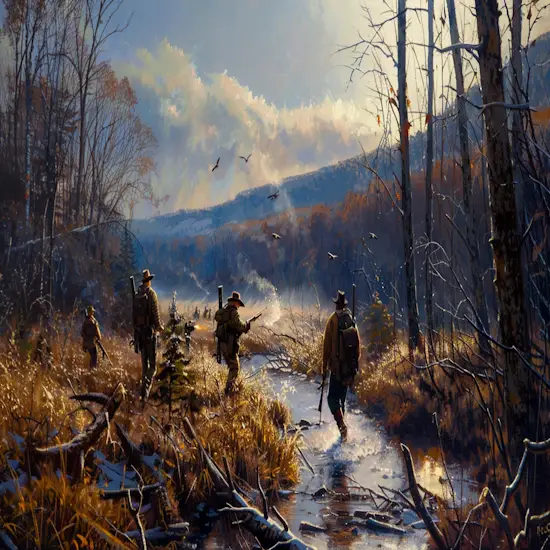
Public Land Considerations
Consider the importance of land access regulations when planning your deer drive on public land. Make sure you comply with safety guidelines to prevent accidents and promote responsible hunting behavior.
Stay aware of the environmental impact of your hunt and take responsibility for maintaining the integrity of the public land you’re utilizing.
Land Access Regulations
When hunting on public land, prioritize safety measures to guarantee a successful and incident-free deer drive.
- Familiarize yourself with the specific regulations governing hunting on public land.
- Obtain all necessary permits and permissions before conducting a deer drive.
- Respect any restricted areas or zones designated for conservation or other purposes.
Understanding and adhering to land access regulations is essential not only for your safety but also to uphold the sustainability of hunting activities on public lands.
Safety Guidelines Compliance
To guarantee a safe and successful deer drive on public land, adherence to safety guidelines is important for all participants. When hunting on public land, it’s vital to follow safety measures diligently. Make sure everyone knows safe shooting directions and refrain from carrying guns if there’s uncertainty about shooting safely.
Proper planning and communication are key components of a secure drive. Always be aware of other hunters’ presence for visibility and adjust plans promptly if unexpected individuals enter the area. By strictly adhering to safety rules and guidelines, you can help ensure a productive and accident-free deer drive on public land.
Stay vigilant, communicate effectively, and prioritize safety above all else.
Environmental Impact Awareness
Awareness of the environmental impact, particularly on public land, is crucial for maintaining sustainable hunting practices. When engaging in deer drives on public land, consider the following:
- Respect wildlife habitats and migration patterns to minimize disruption.
- Adhere to all regulations and restrictions set forth by the managing authorities.
- Clean up after the hunt, including any trash or debris left behind.
Being mindful of the environmental impact guarantees the longevity of hunting opportunities and helps preserve the natural balance of ecosystems. By taking these considerations into account, you contribute to conservation efforts and promote responsible hunting practices on public lands.
Hunter Behavior Responsibility
Respecting wildlife habitats and following regulations is vital for responsible hunting behavior on public land. When hunting on public land, always prioritize safety and respect for the environment.
Be mindful of other hunters and wildlife enthusiasts who share the same space. Make sure you’re familiar with the specific rules and regulations of the area you’re hunting in. Avoid damaging vegetation or leaving behind any litter.
It’s essential to be a responsible steward of the land, leaving it as you found it for others to enjoy. By following these guidelines, you contribute to the preservation of natural habitats and guarantee a positive hunting experience for yourself and others.
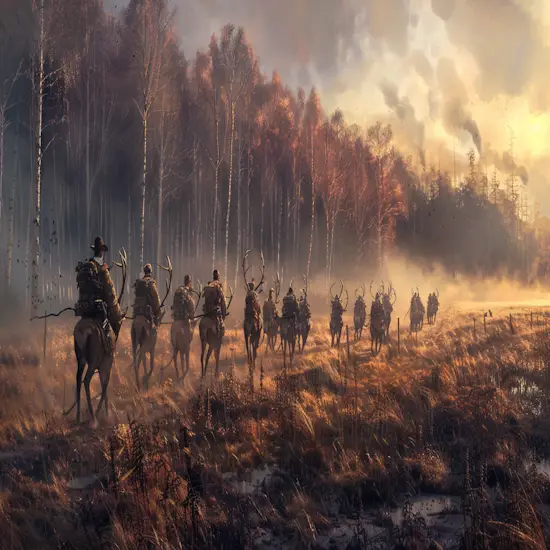
Team Organization
You need to understand the importance of team roles, clear communication signals, strategic stander placement, and safety protocols in successful deer drives. Each member of the team plays a pivotal role in the drive’s effectiveness, so knowing your responsibilities is key.
Effective communication and coordination guarantee everyone is on the same page, enhancing safety and the drive’s success.
Team Roles
To effectively organize a deer drive, establishing clear team roles is crucial for coordination and success in the field. Team roles help guarantee everyone knows their responsibilities and contributes effectively to the drive.
Here are some key roles to contemplate:
- Drivers: Responsible for moving through designated areas to push deer towards standers.
- Standers: Positioned strategically to intercept deer and take shots when opportunities arise.
- Communicators: Facilitate communication between team members, ensuring everyone is informed of the drive’s progress.
Assigning these roles clearly and ensuring everyone understands their duties enhances the drive’s efficiency and increases the chances of a successful hunt.
Communication Signals
Establish designated signals for communication among team members to enhance coordination and safety during the deer drive. Clear signals like whistles, hand gestures, or walkie-talkies can alert others of deer movement, potential dangers, or the end of the drive.
Assign specific signals for stopping the drive, signaling a successful shot opportunity, or notifying others of a safety concern. Consistent and well-understood communication signals are vital for effective teamwork and avoiding accidents.
Make sure all team members know and recognize the designated signals before starting the drive. Practice using the signals to ensure everyone is familiar with their meanings. Good communication enhances coordination, reduces confusion, and ultimately makes the deer drive safer and more successful.
Strategic Standers
Proper positioning of standers plays an important role in the success of a deer drive. Strategic standers should:
- Block escape routes for the deer being moved.
- Be strategically located to prevent deer from evading the drive.
- Match gun to shot opportunities.
Strategic standers are crucial in guiding deer toward the desired direction during a deer drive. By understanding the terrain and deer behavior, standers can effectively intercept deer and increase the chances of a successful hunt.
Ensuring standers are prepared and positioned correctly enhances the overall effectiveness of the drive. Remember, a well-planned setup with standers in strategic positions can greatly impact the outcome of the deer hunting experience.
Safety Protocols
Guarantee your team is well-prepared and follows strict safety protocols during the deer drive to reduce risks and secure a successful hunting experience. Ensure all participants understand safe shooting directions to prevent accidents. Proper communication and planning are crucial for a safe drive.
Position standers strategically to block escape routes and increase the drive’s success. Utilize natural obstacles to guide deer movement towards standers effectively. Establish clear signals for communication and coordination during the drive.
Be adaptable to weather changes and ready to adjust tactics accordingly. Conduct a post-drive analysis to review successes and improve future strategies. Remember, safety is paramount, so prioritize it throughout the deer drive for a successful and incident-free hunting experience.
The Bottom Line
Deer drives for deer hunting is a popular and effective hunting method for deer season. It involves a group of hunters who work together. One team consists of the drivers while the other is waiting for the deer to be driven toward them.
Being alert for quick changes with the drive helps for a successful deer drive. Additionally, safety is also very important during a deer drive. Always follow all safety rules and protocols.
There are big drives and small drives, sometimes just two-man drives. Old fashioned deer drives can be done on public land and private land. Deer drives are often done in open fields but can also be implemented in other areas. A good opportunity to implement a deer drive is close to bedding area where you have a good chance of making a deer move.
The running deer, which often is the first deer, then initiates the deer drive. Usually, the game plan is to block travel lanes, funnels, ridges, and other areas where deer move to during the drive. A morning hunt can be a time for a good drive as a lot of deer will be in the bedded area.
In this article, we discussed deer drives for deer hunting and shared information to help you conduct successful deer drives. You can also read spot and stalk hunting for deer and still hunting for deer.
